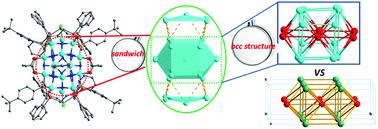Our official English website, www.x-mol.net, welcomes your feedback! (Note: you will need to create a separate account there.)
Observation of a bcc-like framework in polyhydrido copper nanoclusters
Nanoscale ( IF 5.8 ) Pub Date : 2021-11-08 , DOI: 10.1039/d1nr05567d Qi-Lin Guo 1 , Bao-Liang Han 2 , Cun-Fa Sun 1 , Zhi Wang 2 , Yunwen Tao 3 , Jin-Qing Lin 1 , Geng-Geng Luo 1 , Chen-Ho Tung 2 , Di Sun 2
Nanoscale ( IF 5.8 ) Pub Date : 2021-11-08 , DOI: 10.1039/d1nr05567d Qi-Lin Guo 1 , Bao-Liang Han 2 , Cun-Fa Sun 1 , Zhi Wang 2 , Yunwen Tao 3 , Jin-Qing Lin 1 , Geng-Geng Luo 1 , Chen-Ho Tung 2 , Di Sun 2
Affiliation

|
Cu is well-known to adopt a face-centered cubic (fcc) structure in the bulk phase. Ligand-stabilized Cu nanoclusters (NCs) with atomically precise structures are an emerging class of nanomaterials. However, it remains a great challenge to have non-fcc structured Cu NCs. In this contribution, we report the syntheses and total structure determination of six 28-nuclearity polyhydrido Cu NCs: [Cu28H16(dppp)4(RS)4(CF3CO2)8] (dppp = 1,3-bis(diphenylphosphino)propane, RSH = cyclohexylthiol, 1; tert-butylthiol, 3; and 2-thiophenethiol, 4) and [Cu28H16(dppe)4(RS)4(CH3CO2)6Cl2] (dppe = 1,2-bis(diphenylphosphino)ethane, RSH = (4-isopropyl)thiophenol, 2; 4-tert-butylbenzenethiol, 5; and 4-tert-butylbenzylmercaptan, 6). Their well-defined structures solved by X-ray single crystal diffraction reveal that these 28-Cu NCs are isostructural, and the overall metal framework is arranged as a sandwich structure with a core–shell Cu2@Cu16 unit held by two Cu5 fragments. One significant finding is that the organization of 18 Cu atoms in the Cu2@Cu16 could be regarded as an incomplete and distorted version of 3 × 2 × 2 “cutout” of the body-centered cubic (bcc) bulk phase, which was strikingly different to the fcc structure of bulk Cu. The bcc framework came as a surprise, as no bcc structures have been previously observed in Cu NCs. A comparison with the ideal bcc arrangement of 18 Cu atoms in the bcc lattice suggests that the distortion of the bcc structure results from the insertion of interstitial hydrides. The existence, number, and location of hydrides in these polyhydrido Cu NCs are established by combined experimental and DFT results. These results have significant implications for the development of high-nuclearity Cu hydride NCs with a non-fcc architecture.
中文翻译:

多氢化铜纳米团簇中类 bcc 骨架的观察
众所周知,Cu 在体相中采用面心立方 (fcc) 结构。具有原子级精确结构的配体稳定的铜纳米团簇 (NCs) 是一类新兴的纳米材料。然而,拥有非 fcc 结构的 Cu NCs 仍然是一个巨大的挑战。在这篇文章中,我们报告了六个 28 核多氢 Cu NCs 的合成和总结构测定:[Cu 28 H 16 (dppp) 4 (RS) 4 (CF 3 CO 2 ) 8 ] (dppp = 1,3-bis (二苯基膦基)丙烷,RSH = 环己硫醇,1;叔丁基硫醇,3;和 2-噻吩硫醇,4 ) 和 [Cu 28H 16 (dppe) 4 (RS) 4 (CH 3 CO 2 ) 6 Cl 2 ] (dppe = 1,2-双(二苯基膦)乙烷,RSH = (4-异丙基)苯硫酚,2;4-叔丁基苯硫酚,5;和 4-叔丁基苄基硫醇,6 )。通过 X 射线单晶衍射解析出的明确结构表明,这些 28-Cu NCs 是同构的,整个金属框架排列为夹心结构,核 - 壳 Cu 2 @Cu 16单元由两个 Cu 5支撑碎片。一个重要的发现是 Cu 2 @Cu 16中 18 个 Cu 原子的组织可以被视为体心立方 (bcc) 体相的 3 × 2 × 2 “切口”的不完整和扭曲版本,这与块体 Cu 的 fcc 结构截然不同。bcc 框架令人惊讶,因为之前在 Cu NCs 中没有观察到 bcc 结构。与 bcc 晶格中 18 个 Cu 原子的理想 bcc 排列的比较表明 bcc 结构的畸变是由于间隙氢化物的插入造成的。这些多氢化铜 NCs 中氢化物的存在、数量和位置是通过结合实验和 DFT 结果确定的。这些结果对开发具有非 fcc 结构的高核 Cu 氢化物 NC 具有重要意义。
更新日期:2021-11-24
中文翻译:

多氢化铜纳米团簇中类 bcc 骨架的观察
众所周知,Cu 在体相中采用面心立方 (fcc) 结构。具有原子级精确结构的配体稳定的铜纳米团簇 (NCs) 是一类新兴的纳米材料。然而,拥有非 fcc 结构的 Cu NCs 仍然是一个巨大的挑战。在这篇文章中,我们报告了六个 28 核多氢 Cu NCs 的合成和总结构测定:[Cu 28 H 16 (dppp) 4 (RS) 4 (CF 3 CO 2 ) 8 ] (dppp = 1,3-bis (二苯基膦基)丙烷,RSH = 环己硫醇,1;叔丁基硫醇,3;和 2-噻吩硫醇,4 ) 和 [Cu 28H 16 (dppe) 4 (RS) 4 (CH 3 CO 2 ) 6 Cl 2 ] (dppe = 1,2-双(二苯基膦)乙烷,RSH = (4-异丙基)苯硫酚,2;4-叔丁基苯硫酚,5;和 4-叔丁基苄基硫醇,6 )。通过 X 射线单晶衍射解析出的明确结构表明,这些 28-Cu NCs 是同构的,整个金属框架排列为夹心结构,核 - 壳 Cu 2 @Cu 16单元由两个 Cu 5支撑碎片。一个重要的发现是 Cu 2 @Cu 16中 18 个 Cu 原子的组织可以被视为体心立方 (bcc) 体相的 3 × 2 × 2 “切口”的不完整和扭曲版本,这与块体 Cu 的 fcc 结构截然不同。bcc 框架令人惊讶,因为之前在 Cu NCs 中没有观察到 bcc 结构。与 bcc 晶格中 18 个 Cu 原子的理想 bcc 排列的比较表明 bcc 结构的畸变是由于间隙氢化物的插入造成的。这些多氢化铜 NCs 中氢化物的存在、数量和位置是通过结合实验和 DFT 结果确定的。这些结果对开发具有非 fcc 结构的高核 Cu 氢化物 NC 具有重要意义。















































 京公网安备 11010802027423号
京公网安备 11010802027423号